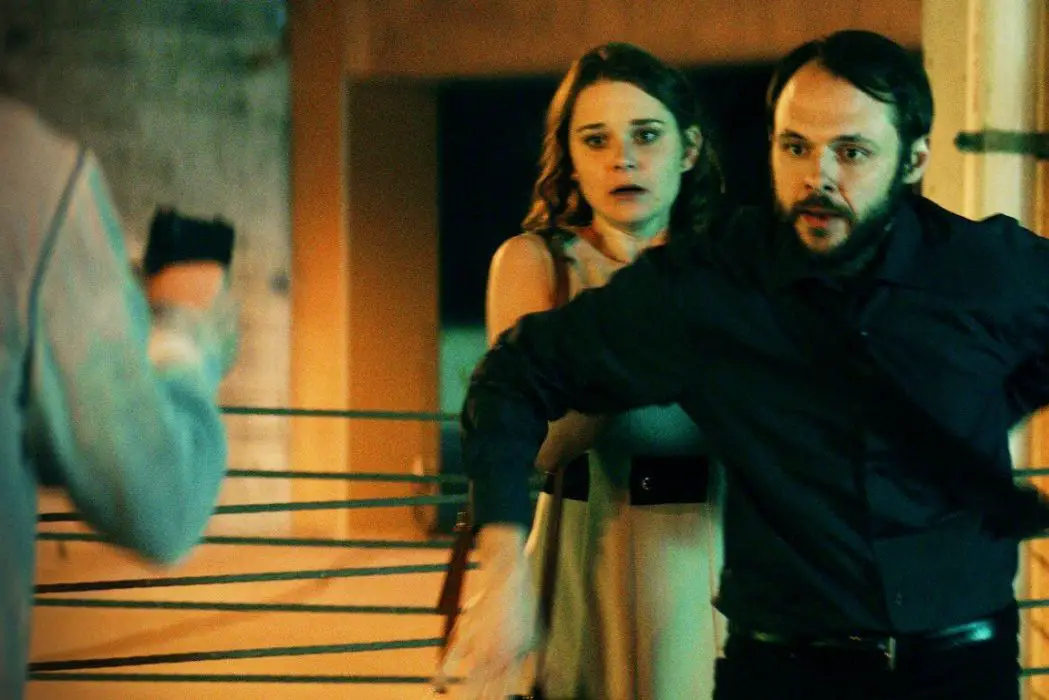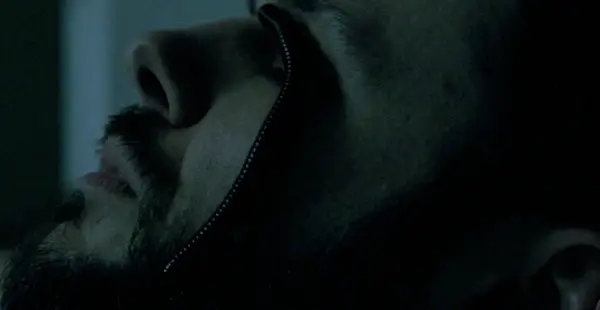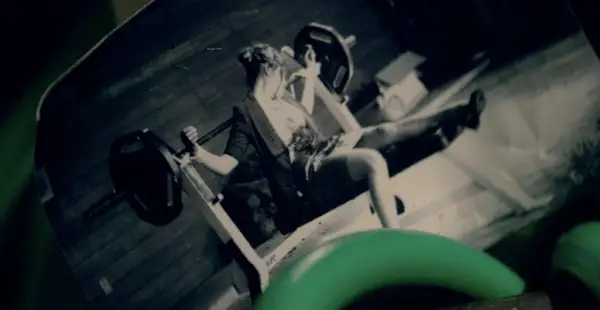CAMERA OBSCURA: A Snapshot Of War’s Lingering Horror

Chris is a B.A.H. graduate with a concentration in pre-19th…
When post-traumatic stress disorder (PTSD) is tackled in film, it’s more often than not through drama. That’s not to say it can’t be explored in other genres. The terror of war can be illustrated well within the genre of horror itself, and PTSD particularly takes on an even more terrifying form when its effects are imagined in the context of psychological horror. That’s exactly where director Aaron B. Koontz’s Camera Obscura comes in.
Koontz and co-writer Cameron Burns take on the lingering damage of PTSD with the story of Jack Zeller (Christopher Denham), a war photographer whose civilian life is affected by his stressful job. When his wife Claire (Nadja Bobyleva, read my interview with her here) gives him a new camera, Jack begins to believe it’s cursed, and soon the line between reality and nightmare becomes blurred.
The psychological horror is unnerving, due to several factors. First, the acting from Denham and Bobyleva grounds the film in reality, as they feel natural together like a real couple. Second, because of how Koontz presents the plot and everything we see the audience, like Jack, remains unsure of whether the camera is supernatural, or if Jack is losing his mind. The story weaves from one scene to the next, continually challenging our expectations. Finally, the entirety of Jack’s experience acts as an overall metaphor for the mental anguish of PTSD and how it can permanently warp the mind.
Rooted In Reality
Horror movies do themselves great service when their characters, no matter how far-fetched the plot gets, remain grounded. While there’s a possibly supernatural camera at the heart of Camera Obscura, the story feels genuine because of how Burns and Koontz wrote their characters, as well as how Denham and Bobyleva portray them onscreen.
Bobyleva provides the counterpoint to Jack as his wife Claire, whose dedication in helping her husband overcome his PTSD is admirable and lovable. She plays the character with the right amount of care, but also Claire is both written and played as an honest human being. At a certain point she can no longer ignore the possibility that her husband’s PTSD has become something else entirely.
Along with character, the film’s story is directed by Koontz in such a way that, up until the last minutes, the answer to the horror in Jack’s life is left a mystery.
Psychotic Reality
Denham’s Jack goes through the ringer while trying to figure out if he’s seeing things or if the camera Claire gave him is supernatural. He begins taking photographs only to discover they’re capturing deaths which haven’t yet happened; not long after they’re developed, the deaths occur. He, and the audience, are convinced early on there’s a secretive history behind the object, that it’s been cursed.

However, once Jack starts investigating, his hallucinations likewise commence. This is where Koontz visually calls into question the character’s sanity, though not giving us any answers until the finale. Jack first dreams of a centipede crawling over his face, then hallucinates pulling out a bunch of teeth, his mouth bleeding uncontrollably. Later, the visions get worse, more realistic, and he even loses time.
The scariest part of Jack’s psychological journey is after he makes a choice of questionable morality. At this juncture the audience is put in a position where, depending on what one believes is the plot’s truth, this choice can be seen as utterly sinister. From this moment on the line between reality and psychosis is separated by a tiny margin, in it lying the depths of the film’s horror.
It doesn’t really matter if the story’s conclusion confirms or denies the viewer’s personal predictions. Koontz uses the film as a way of relating the existential dread involved in PTSD, particularly in those who’ve experienced war. So that no matter how the story concludes, Jack’s disorder represents the lingering trauma of death on those who bear witness.
PTSD: Horror Of The Mind
One of the strongest elements in Camera Obscura is that, regardless if Jack is losing touch with reality or the camera is haunted, the whole story is itself a metaphor for the horror of PTSD. On the one hand, obviously if he turns out to be mentally ill and causes all the terror we witness, this is a literal interpretation of his PTSD. On the other hand, if the camera’s haunted this provides an even more horrific vision of the disorder.

When Jack sees the death photographs develop, he takes it upon himself to try stopping each death. No longer is he a photographer only barely removed from the subjects his lens captures, he is now transformed into a soldier, tasked with saving the day; or else witness further death. Like the mental anguish of PTSD, this is a perpetual state of needing to be the saviour, as if Jack is going back over the death of war he’s seen before in a desperate attempt to change the outcome.
The PTSD from which many soldiers and war photographers suffer often takes the form of reliving those experiences, flashbacks or otherwise. The photographs Jack takes with the camera are themselves an affirmation of the disorder, that death is everywhere. Part of his PTSD lies in the idea that, as a photographer he cemented moments of death in his pictures; in a sense, he trafficked in the death of others, profiting off their corpses. Therefore, it doesn’t matter if the camera is haunted or if it’s every bit a manifestation of the disorder: Jack is being punished by his inability to not see death everywhere he looks.
Conclusion
PTSD isn’t an easy subject to discuss through film, as it can mean so many things to different people depending on their personal situation. From Taxi Driver to newer films like Disorder, there are a number of ways to portray the human mind while dealing with such difficult mental illness. What Koontz does so well is present a double-edged sword, where neither theory of what is happening is confirmed until the last moments.
The film ends with a creepy image, one that calls back to an earlier moment when the plot is just starting to gear up. Visually, there is a way to connect all the dots, and there’s little doubt that the story is meant to finish on a concrete note. But much as the old adage goes, the end justifies the means, and it isn’t so much a clear ending that matters. Most important is the journey.
No matter the conclusion, Camera Obscura looks head-on at PTSD, making clear that it is a never-ending illness, one that manifests in more than one form. Steeped in psychological terror and doses of very real horror, Koontz takes the audience on a journey which ultimately parallels the scramble of Jack’s mind in uncovering the truth.
Does horror help relay the psychological trauma of PTSD in a tangible way? Or do the genre’s traits lessen the impact of such emotionally weighty material?
Camera Obscura opened in American theaters on June 9, and will become available on VOD and digital HD June 13, 2017.
Does content like this matter to you?
Become a Member and support film journalism. Unlock access to all of Film Inquiry`s great articles. Join a community of like-minded readers who are passionate about cinema - get access to our private members Network, give back to independent filmmakers, and more.
Chris is a B.A.H. graduate with a concentration in pre-19th century literature from Memorial University of Newfoundland. His short stories have been published in The Cuffer Anthology Volumes VI & VII, as well as upcoming stories in new anthologies from Centum Press (One Hundred Voices & One Hundred Voices Pt. II) and Science Fiction Reader. A short screenplay of his titled "New Woman" is currently being produced, to be shot in 2017; it is a female-led dramatic horror, a period piece set in 1888.













